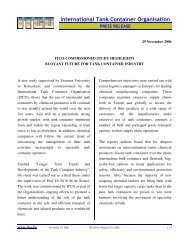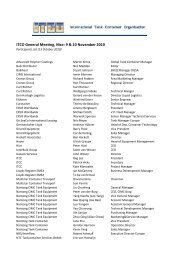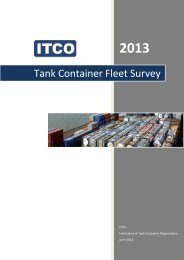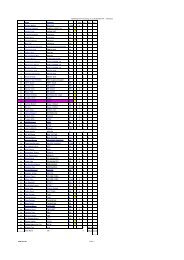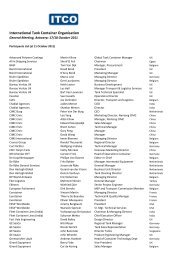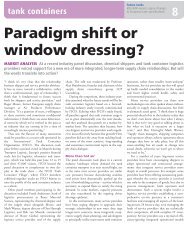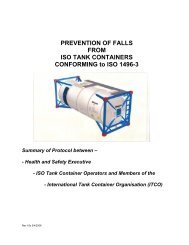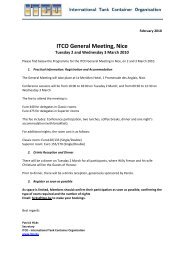You also want an ePaper? Increase the reach of your titles
YUMPU automatically turns print PDFs into web optimized ePapers that Google loves.
ICHCA International <strong>Safe</strong>ty Panel Briefing Pamphlet No 30<br />
8.3.2 All the dangerous goods regulations require the marks and placards to be<br />
affixed to tank containers in such a way as to be legible and durable. All<br />
marks and placards are required to be affixed in such a way as to remain<br />
legible for up to three months in the sea.<br />
Note: <strong>Tank</strong> containers with placards not completely adhering to the<br />
container (for example, corners which are lifting up) or with air<br />
bubbles trapped under them (and therefore not durably marked)<br />
under them should not be accepted for transport.<br />
9 Cargoes Carried<br />
9.1 <strong>Tank</strong> containers are used for the transportation <strong>of</strong> bulk liquids, liquefied gases,<br />
deeply refrigerated (cryogenic) gases, powders and granules. Generally the<br />
type <strong>of</strong> product will dictate the design <strong>of</strong> the tank container. However within<br />
each tank group type the products may be regulated as hazardous goods or<br />
non-regulated. Cargoes can be further designated as food grade (hazardous<br />
and non-regulated), kosher, and drug regulated, etc.<br />
Note: Cargo handlers should be aware that some cargoes carried in tank<br />
containers can have a high specific gravity and thus even a small<br />
volume tank may carry a very heavy cargo.<br />
9.2 Dangerous Goods<br />
9.2.1 <strong>Tank</strong> containers can carry a variety <strong>of</strong> dangerous goods, and where the tank<br />
container is made up <strong>of</strong> two or more compartments, the tank container may<br />
carry more than one compatible dangerous good.<br />
9.2.2 See Annex 5 for reference to dangerous goods.<br />
9.2.3 All dangerous goods shall be referred to by their Proper Shipping Name<br />
(see Annex 3)<br />
9.3 Non Regulated Goods<br />
9.3.1 For the purposes <strong>of</strong> this pamphlet, non regulated goods refer to all <strong>of</strong> those<br />
products not covered by the IMDG Code, but that does not mean that some<br />
<strong>of</strong> them are not hazardous. Modes <strong>of</strong> transport other than by sea may have<br />
different designations.<br />
9.3.2 Examples <strong>of</strong> non regulated, non food goods that are typically transported in<br />
tank containers are:<br />
latex<br />
linseed oil<br />
drilling mud<br />
emulsions<br />
detergents<br />
9.3.3 Examples <strong>of</strong> non regulated food goods that are typically transported in tank<br />
containers:<br />
vegetable and other edible oils<br />
wine<br />
fruit juices (chilled and refrigerated)<br />
Page 30 ©ICHCA International Limited



